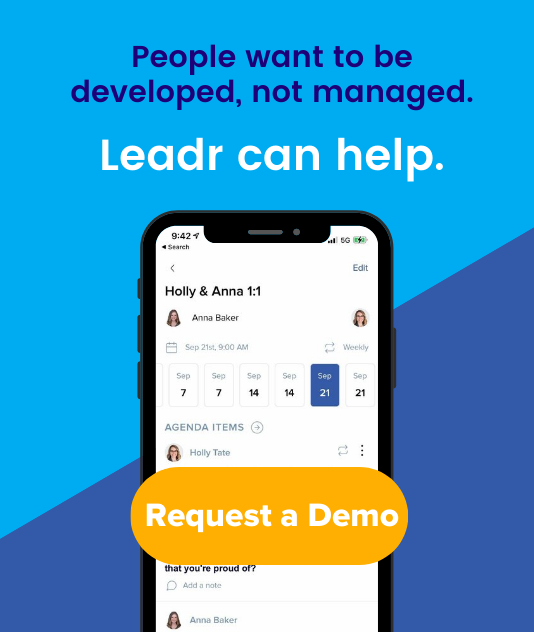Three Steps to More Effective 1:1 Meetings
One-on-one meetings are one of the most powerful and simple tools you have to help you lead as a manager, and yet they are also one of the most misunderstood and underused (or even sometimes, misused) tools too. Why?
Somewhere along the way, the one-on-one meeting picked up a stigma it doesn’t deserve: that when your manager or boss sends you a meeting invite, you must have done something wrong. That no communication means everything is going well. That one more meeting is just another headache of an unproductive hour to look forward to.
But when they are done consistently and conducted with thoughtfulness and intentionality, they can be an effective way to triage small issues before they become big problems, invest in others’ growth and development, and leave team members feeling valued and heard.
So what do you do next? Here are three simple steps to making your one on one meetings more effective:
Have an agenda.
One of the best ways to ensure you stay on track is to plan it out. But be sure to plan some time for your team to share whatever is on their mind. Maybe you spend 10 minutes instead of the planned five talking about their weekend because something big happened - that’s a great way to show you care about them as a person, not just a to-do list machine (even if they are nailing the productivity game).
A transparent, shared agenda also allows you and your team members to add things ahead of time, creating buy-in from your team on how the meeting operates. They’ll feel a sense of ownership over their role and their contributions and feel like the meeting is worth their time, too. This is great because you may want to be prepared with a resource or have a game plan for solving an issue and they won’t catch you off guard. Leadr allows you to set up an agenda right within the software, and add space for feedback after the meeting is over.
Having an agenda doesn’t just make sure you talk about everything you need to, but it also creates intentional space for relationship building and development. Setting aside time specifically for developing people is a surefire way to greater client delight, lower turnover, and cohesive collaboration.
Let the employee lead.
When you let your team member lead, this creates relational equity. They no longer see this meeting as “meet with my boss so they can make sure I’m doing everything the boss wants.” (We’ve all been there). Instead, this is a conversation about how you can help.
To understand best how you can support, guide, or equip your employee, let them lead the conversation. They may surprise you when given space to lead by sharing ways to improve processes or opening up to questions or ideas about their role or their future at the organization.
This is also a way for you to help an employee prioritize tasks - they may bring up something that is taking them too long to do, and you can help them shift their to-do list that maximizes their time and is a win for the organization. When they feel like it is a two-way conversation where feedback can be shared both ways, that’s truly where you both win because growth happens on both sides.
Be open to feedback - listen more than you talk.
Leaders are often high on the “red” side of the DiSC or work personality spectrum - meaning, your brain is working really fast and you only have a few minutes to spare, so get to the details quick! And while we can appreciate this get-it-done style, it may benefit your one-on-one meetings to have a slower pace. By this we mean - listen more than you talk!
This is one part of letting your team lead, but it also means that you are open to feedback. Try to resist the urge to interrupt and just listen to what your employee has to say. Feedback works better when you can give great feedback AND receive it well. That way, your team member feels heard and supported and you’re taking steps to improve processes and work that benefits the entire team.
Although it might feel like an awkward process right now, with time and practice, the one-on-one meeting will become a natural rhythm that you find invaluable in your weekly schedule. Your team might even look forward to the time they get talking to you when you approach it with flexibility and openness - some incredible creativity and innovation can happen when you consistently invest in growth. That mindset goes for employee, manager, and organization as a whole.
Want to see Leadr in action to get a closer look at how we implement effective one on one meetings and how our software can turn the 1:1 meeting into your most important leadership development tool? We’d love to show you around. Request a demo here.
Share this
You May Also Like
These Related Stories

Four Tricks to Leading Up and Giving Feedback to Your Boss

How to PTO Like a Boss






No Comments Yet
Let us know what you think